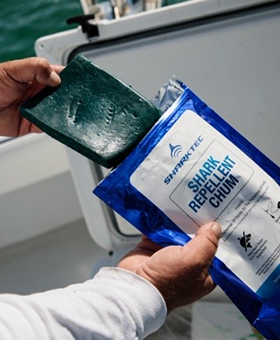The full Ocean and Costal Management publication can be found here
Study Overview
Product chemicals produced from putrefied shark tissue was evaluated over a five-year period in South Bimini, Bahamas. Competitively-feeding populations of Caribbean reef sharks and blacknose sharks were exposed to the chemicals using pressurized aerosol canisters at the surface. The number of sharks in the testing area were counted at the initial, 1 min and 5 min intervals after preliminary exposure along with continuous exposure of feeding stimulus.
Study Breakdown
- Thirteen field tests conducted between 2005 and 2010
- For all field tests, 100% of the sharks rapidly accelerated away from the repellent chemical plume within 1 min after product was released.
- With continuous bait and chum present, a limited number of sharks began to return after 10 min.
- Returning sharks were always Caribbean Reef sharks; blacknose sharks did not return after chemical exposure within this period.
- The returning Caribbean Reef population was always less than half of the initial population and these sharks were noticeably disinterested in feeding.
- It appeared that sharks were investigating food that had fallen to the seafloor, a dramatic contrast to competitive surface feeding.
- The black durgon, oceanic triggerfish, queen triggerfish, Bermuda chub, and yellowtail snapper were the most abundant fish present during the trials.
- Many fish were observed swimming through the chemical plume after sharks had left the immediate area and before the canister completed its ejection.
- These fish displayed no aversion behaviors and would continue feeding long after the sharks had left the test site, thus, the repellent was observed to act selectively on sharks.
Study Takeaways
- For all tests conducted at Triangle Rocks, South Bimini over a five year period, aversion behaviors were unambiguous and sudden, with sharks losing interest in feeding and accelerating beyond visual range within 1 min of local dispersion of the chemical
- Experimental controls using denatured ethanol or water confirmed that feeding sharks were not deterred by bubbles, sound, or the solvents used to extract the chemical. The existence of a putative chemical shark repellent has been confirmed.
- Aerosol canisters produced an unexpected benefit for delivery. The motion and noise produced by the evacuating control canisters and empty control canisters floating at the surface appeared to heighten the sharks’ interest in approaching the cans.
- The authors propose that the evacuating can either visually resembles a struggling prey item or the evacuation noise is attractive.
- Often, control canisters were bitten, nosed, or temporarily pulled underwater. The canisters therefore served as lures to ensure that sharks contacted the chemical plume



